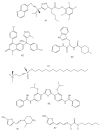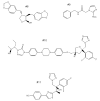Advances in Chagas disease drug development: 2009-2010
- PMID: 20885320
- PMCID: PMC3603362
- DOI: 10.1097/QCO.0b013e3283402956
Advances in Chagas disease drug development: 2009-2010
Abstract
Purpose of review: The need for better drugs to treat patients with Chagas disease remains urgent. This review summarizes the advancements in drug development over the past 2 years.
Recent findings: Drug development efforts are almost exclusively occurring as preclinical research, although phase II studies for the antifungal drug, posaconazole, and a prodrug of ravuconazole are being planned. Several recent laboratory investigations demonstrate anti-Trypanosoma cruzi activity of novel small molecules in animal models. These include nonpeptidic cruzain inhibitors, novel inhibitors of the sterol 14α-demethylase enzyme, new compounds (arylimidamides) related to pentamidine, derivatives of nifurtimox, compounds using ruthenium complexes, and several natural products. The recent implementation of a high-throughput screen of more than 300 000 compounds against intracellular T. cruzi amastigotes done at the Broad Institute is an important development, yielding approximately 300 selective inhibitors, many of which may serve as leads for medicinal chemistry efforts.
Summary: Progress is slow, but recent advancements in both drug development and advocacy for research on neglected diseases are encouraging. Efforts to define a target product profile and to harmonize methodologies for testing drugs for Chagas disease are described herein.
Figures


Similar articles
-
In vitro and in vivo studies of the antiparasitic activity of sterol 14α-demethylase (CYP51) inhibitor VNI against drug-resistant strains of Trypanosoma cruzi.Antimicrob Agents Chemother. 2013 Sep;57(9):4151-63. doi: 10.1128/AAC.00070-13. Epub 2013 Jun 17. Antimicrob Agents Chemother. 2013. PMID: 23774435 Free PMC article.
-
Clear Shot at Primary Aim: Susceptibility of Trypanosoma cruzi Organelles, Structures and Molecular Targets to Drug Treatment.Curr Top Med Chem. 2017;17(10):1212-1234. doi: 10.2174/1568026616666161025161858. Curr Top Med Chem. 2017. PMID: 27784255 Review.
-
Antitrypanosomal Activity of Sterol 14α-Demethylase (CYP51) Inhibitors VNI and VFV in the Swiss Mouse Models of Chagas Disease Induced by the Trypanosoma cruzi Y Strain.Antimicrob Agents Chemother. 2017 Mar 24;61(4):e02098-16. doi: 10.1128/AAC.02098-16. Print 2017 Apr. Antimicrob Agents Chemother. 2017. PMID: 28167559 Free PMC article.
-
Development of a Fluorescence-based Trypanosoma cruzi CYP51 Inhibition Assay for Effective Compound Triaging in Drug Discovery Programmes for Chagas Disease.PLoS Negl Trop Dis. 2015 Sep 22;9(9):e0004014. doi: 10.1371/journal.pntd.0004014. eCollection 2015 Sep. PLoS Negl Trop Dis. 2015. PMID: 26394211 Free PMC article.
-
Chagas Disease and Coumarins: A Review of Natural and Synthetic Coumarins As Anti-Trypanosoma Cruzi Agents.Mini Rev Med Chem. 2021;21(13):1701-1717. doi: 10.2174/1389557521666201229125931. Mini Rev Med Chem. 2021. PMID: 33372872 Review.
Cited by
-
Experimental Chemotherapy for Chagas Disease: A Morphological, Biochemical, and Proteomic Overview of Potential Trypanosoma cruzi Targets of Amidines Derivatives and Naphthoquinones.Mol Biol Int. 2011;2011:306928. doi: 10.4061/2011/306928. Epub 2011 Jun 30. Mol Biol Int. 2011. PMID: 22091400 Free PMC article.
-
Utilizing Chemical Genomics to Identify Cytochrome b as a Novel Drug Target for Chagas Disease.PLoS Pathog. 2015 Jul 17;11(7):e1005058. doi: 10.1371/journal.ppat.1005058. eCollection 2015 Jul. PLoS Pathog. 2015. PMID: 26186534 Free PMC article.
-
Gene expression study using real-time PCR identifies an NTR gene as a major marker of resistance to benzonidazole in Trypanosoma cruzi.Parasit Vectors. 2011 Sep 5;4:169. doi: 10.1186/1756-3305-4-169. Parasit Vectors. 2011. PMID: 21892937 Free PMC article.
-
The Trypanosoma cruzi protease cruzain mediates immune evasion.PLoS Pathog. 2011 Sep;7(9):e1002139. doi: 10.1371/journal.ppat.1002139. Epub 2011 Sep 1. PLoS Pathog. 2011. PMID: 21909255 Free PMC article.
-
Sequential combined treatment with allopurinol and benznidazole in the chronic phase of Trypanosoma cruzi infection: a pilot study.J Antimicrob Chemother. 2013 Feb;68(2):424-37. doi: 10.1093/jac/dks390. Epub 2012 Oct 26. J Antimicrob Chemother. 2013. PMID: 23104493 Free PMC article. Clinical Trial.
References
-
- Bern C, Montgomery SP, Herwaldt BL, et al. Evaluation and treatment of Chagas disease in the United States: a systematic review. JAMA. 2007;298:2171–2181. - PubMed
-
- Rassi A, Jr., Rassi A, Marin-Neto JA. Chagas disease. Lancet. 2010;375:1388–1402. - PubMed
-
- Urbina JA. Specific chemotherapy of Chagas disease: relevance, current limitations and new approaches. Acta Trop. 2010;115:55–68. - PubMed
-
-
Marin-Neto JA, Rassi A, Jr., Avezum A, et al. The BENEFIT trial: testing the hypothesis that trypanocidal therapy is beneficial for patients with chronic Chagas heart disease. Mem Inst Oswaldo Cruz. 2009;104(1 Suppl):319–324. This provides an update of the ongoing BENEFIT (Benznidazole Evaluation for Interrupting Trypanosomiasis) trial, which consists of a pilot study and a full-scale trial with 3000 patients. It is the first clinical trial on a large scale to be conducted for Chagas disease.
-
-
- Clayton J. Chagas disease: pushing through the pipeline. Nature. 2010;465:S12–S15. - PubMed
Publication types
MeSH terms
Substances
Grants and funding
LinkOut - more resources
Full Text Sources
Medical
Research Materials
Miscellaneous

